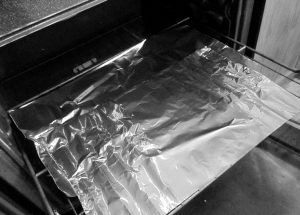Problems Caused By Lining Your Oven With Foil
While keeping your oven floor or racks covered with foil may appear to be a good idea to save cleaning time, it can create a number of problems that range from the frustrating, affecting cooking times to the dangerous.
Lining the bottom of your gas oven can create interference with the flames. This will lead to improperly cooked food as hot and cold spots are created. Additionally, these issues may eventually cause damage to your stove.
Using foil on your oven racks or floor can also create airflow problems. The foil can block heat and cause uneven or improperly cooked dishes. The heat reflected off your foil can increase cooking times. So, you may find that delicate or time-sensitive items such as cakes can cook faster and become burned or dried out.
Finally using foil on the bottom of your oven can be dangerous. Since the foil may have difficulty withstanding the high temperatures, it could melt and adhere to the oven surface. This could cause permanent damage as you are likely to struggle to lift the burned foil remnants from the oven surface. Additionally, the heat that is reflected off the foil could cause the heating elements inside your oven to burn out.
Alternatives to Protecting Your Oven
While foil may not be an appropriate choice for protecting your oven, this doesn’t mean that you’ll be stuck cleaning up sticky messes. In most cases, the mess at the bottom of the oven is caused by spills. If you have a shaky hand when loading your oven, you should try placing your baking dish on a cookie sheet or tray. This will provide you with a more steady surface to load the oven. A cookie sheet will also catch any drips from a baking pie, bubbling casserole or other potentially messy dish.
When baking, think about the potential rise of your creations before you put it in the oven. Don’t overload muffin cases, cake pans or other dishes that could end up spilling onto the oven bottom. Generally, muffin cases and cake pans should be filled to a maximum of ¾ to allow room for the baked items to rise. Using a cookie sheet as a base for your cake tins or pans allows for easy clean up as the cookie sheet can simply be placed in your dishwasher when you’ve finished baking.
If you’re still worried about oven spills, you could consider a silicone oven liner. These products are designed to be used inside an oven and are completely heat resistant. This means that there is no need to worry about melting and silicone is non-reflective. Oven liners should only be used in convection or electric ovens as they are unsuitable for gas ovens.
There are a myriad of issues that you may face with your oven, but learning some basic details can help you deal with more simple repair projects. While many common repair issues can be easily solved, for a more effective and long-lasting solution, you can rely on a professional home appliance repair technician.
For help with all your oven repair needs, ensure you speak to a professional appliance repair service.
